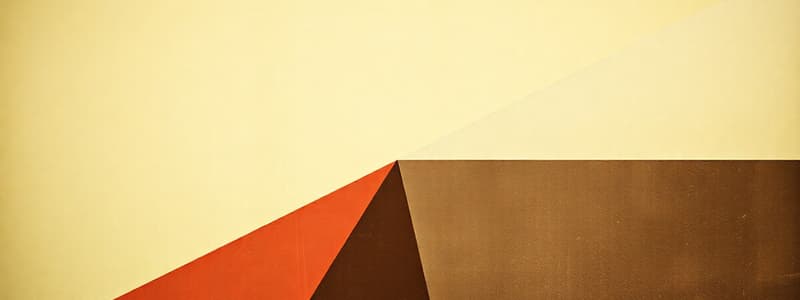Podcast
Questions and Answers
What is the conjugation relation for a plane mirror?
What is the conjugation relation for a plane mirror?
- ¯ ′ H A = 2H A
- ¯ ′ H A = H A
- ¯ ′ H A = 1/2H A
- ¯ ′ H A = −H A (correct)
What is the magnification of an object through a plane mirror?
What is the magnification of an object through a plane mirror?
- 1 (correct)
- 1/2
- 2
- Depends on the size of the object
What is the key characteristic of a spherical diopter?
What is the key characteristic of a spherical diopter?
- It allows light to travel only in one direction.
- It has a curved interface. (correct)
- It reflects light instead of refracting it.
- It has a flat interface.
Which of the following defines a convex spherical diopter?
Which of the following defines a convex spherical diopter?
How many rays are typically used to geometrically construct the image of an object through a spherical diopter?
How many rays are typically used to geometrically construct the image of an object through a spherical diopter?
Which of the following rays is used to construct an image of an object through a spherical diopter?
Which of the following rays is used to construct an image of an object through a spherical diopter?
If a ray of light passes through the center of curvature (C) of a spherical diopter, what happens to the ray?
If a ray of light passes through the center of curvature (C) of a spherical diopter, what happens to the ray?
What is the relationship between the incident angle (i1) and the refracted angle (i2) in a diopter, according to Gauss' Law?
What is the relationship between the incident angle (i1) and the refracted angle (i2) in a diopter, according to Gauss' Law?
What is the magnification (γ) of an object through a plane diopter, expressed in terms of object and image heights?
What is the magnification (γ) of an object through a plane diopter, expressed in terms of object and image heights?
How is Chasles' relation applied to determine the magnification (γ) in a plane diopter?
How is Chasles' relation applied to determine the magnification (γ) in a plane diopter?
What is the relationship between the distances from the diopter to the object (H A1) and the image (H A2), based on the refractive indices?
What is the relationship between the distances from the diopter to the object (H A1) and the image (H A2), based on the refractive indices?
Based on the provided information, what is the magnification (γ) of an object through a plane diopter in terms of the refractive indices (n1 and n2)?
Based on the provided information, what is the magnification (γ) of an object through a plane diopter in terms of the refractive indices (n1 and n2)?
What is the key characteristic of a plane mirror as an optical system?
What is the key characteristic of a plane mirror as an optical system?
Why does the magnification of a plane diopter not depend on object position?
Why does the magnification of a plane diopter not depend on object position?
How can we construct the image of an object through a plane mirror?
How can we construct the image of an object through a plane mirror?
What does the magnification formula for a spherical dioptre tell us?
What does the magnification formula for a spherical dioptre tell us?
What is the defining characteristic of a thin lens according to the text?
What is the defining characteristic of a thin lens according to the text?
What is the typical role of a lens in optical systems?
What is the typical role of a lens in optical systems?
What is the difference between a convergent and a divergent dioptre, as described in the text?
What is the difference between a convergent and a divergent dioptre, as described in the text?
What is the relationship between the optical center of a lens and a ray of light passing through it?
What is the relationship between the optical center of a lens and a ray of light passing through it?
What is the defining characteristic of a lens, according to the text?
What is the defining characteristic of a lens, according to the text?
What is the purpose of the conjugation formula as discussed?
What is the purpose of the conjugation formula as discussed?
What is the relationship between the focal length (SF′′) and the object distance (SC.n) for a convergent dioptre, as described in the text?
What is the relationship between the focal length (SF′′) and the object distance (SC.n) for a convergent dioptre, as described in the text?
What is the name given to a system that involves light passing through a flat surface separating two media with different refractive indices?
What is the name given to a system that involves light passing through a flat surface separating two media with different refractive indices?
Which of the following is NOT a characteristic of a plane mirror?
Which of the following is NOT a characteristic of a plane mirror?
In the context of spherical systems, what does the term 'conjugation' refer to?
In the context of spherical systems, what does the term 'conjugation' refer to?
What is the optical center of a lens?
What is the optical center of a lens?
Which of these is a characteristic of a converging lens?
Which of these is a characteristic of a converging lens?
The focal length of a lens is defined as the distance between the lens and:
The focal length of a lens is defined as the distance between the lens and:
What does the magnification of a lens describe?
What does the magnification of a lens describe?
Consider an object placed at a distance greater than the focal length of a converging lens. What type of image will be formed?
Consider an object placed at a distance greater than the focal length of a converging lens. What type of image will be formed?
What is the key characteristic that distinguishes planar systems in optics?
What is the key characteristic that distinguishes planar systems in optics?
What does the conjugation relation equation describe for a spherical dioptre?
What does the conjugation relation equation describe for a spherical dioptre?
What is the primary function of a planar diopter in optics?
What is the primary function of a planar diopter in optics?
What does the term 'stigmatic' refer to in the context of optical systems?
What does the term 'stigmatic' refer to in the context of optical systems?
What is the formula for the focal power (ν) of a spherical dioptre?
What is the formula for the focal power (ν) of a spherical dioptre?
What is the conjugation relation in the context of planar diopters?
What is the conjugation relation in the context of planar diopters?
What is the unit of measurement for focal power (ν)?
What is the unit of measurement for focal power (ν)?
What does a positive value of focal power (ν) indicate about a spherical dioptre?
What does a positive value of focal power (ν) indicate about a spherical dioptre?
Why is the planar diopter considered to have approximate stigmatism?
Why is the planar diopter considered to have approximate stigmatism?
What happens to the image location when the object is placed at infinity (OA → ∞)?
What happens to the image location when the object is placed at infinity (OA → ∞)?
What is the meaning of 'Gauss conditions' in the context of planar diopters?
What is the meaning of 'Gauss conditions' in the context of planar diopters?
What is the formula for the distance to the object focus (SF) of a spherical dioptre?
What is the formula for the distance to the object focus (SF) of a spherical dioptre?
How is the conjugation relation for a planar diopter mathematically expressed?
How is the conjugation relation for a planar diopter mathematically expressed?
What is the relationship between the curvature (SC) of a spherical dioptre and its focal power (ν)?
What is the relationship between the curvature (SC) of a spherical dioptre and its focal power (ν)?
What is the critical difference between a planar diopter and a spherical diopter?
What is the critical difference between a planar diopter and a spherical diopter?
What is the difference between a convergent dioptre and a divergent dioptre?
What is the difference between a convergent dioptre and a divergent dioptre?
Flashcards
Geometric Optics
Geometric Optics
The branch of optics that describes light propagation in terms of rays.
Planar Systems
Planar Systems
Optical systems involving flat surfaces where light interacts through reflection or refraction.
Refractive Systems
Refractive Systems
Optical systems that bend light as it passes through different media.
Reflective Systems
Reflective Systems
Signup and view all the flashcards
Spherical Systems
Spherical Systems
Signup and view all the flashcards
Focal Length
Focal Length
Signup and view all the flashcards
Magnification
Magnification
Signup and view all the flashcards
Optical Center
Optical Center
Signup and view all the flashcards
Spherical Diopters
Spherical Diopters
Signup and view all the flashcards
Lenses
Lenses
Signup and view all the flashcards
Conjugation Relation
Conjugation Relation
Signup and view all the flashcards
Planar Diopter
Planar Diopter
Signup and view all the flashcards
Stigmatic System
Stigmatic System
Signup and view all the flashcards
Gauss Conditions
Gauss Conditions
Signup and view all the flashcards
Image Points through Planar Diopter
Image Points through Planar Diopter
Signup and view all the flashcards
Image Point in Mirror
Image Point in Mirror
Signup and view all the flashcards
Plane Mirror Magnification
Plane Mirror Magnification
Signup and view all the flashcards
Convex Diopter
Convex Diopter
Signup and view all the flashcards
Concave Diopter
Concave Diopter
Signup and view all the flashcards
Geometric Image Construction
Geometric Image Construction
Signup and view all the flashcards
Ray Behavior in Construction
Ray Behavior in Construction
Signup and view all the flashcards
Incidence Point (I)
Incidence Point (I)
Signup and view all the flashcards
Conjugation Formula
Conjugation Formula
Signup and view all the flashcards
Magnification Formula
Magnification Formula
Signup and view all the flashcards
Chasles' Relation
Chasles' Relation
Signup and view all the flashcards
Stigmatic Image
Stigmatic Image
Signup and view all the flashcards
Law of Reflection
Law of Reflection
Signup and view all the flashcards
Refraction Index (n)
Refraction Index (n)
Signup and view all the flashcards
Focal Power (ν)
Focal Power (ν)
Signup and view all the flashcards
Curvature of the Diopter (SC)
Curvature of the Diopter (SC)
Signup and view all the flashcards
Object Focus (SF)
Object Focus (SF)
Signup and view all the flashcards
Image Focus
Image Focus
Signup and view all the flashcards
Types of Diopters
Types of Diopters
Signup and view all the flashcards
Vergence
Vergence
Signup and view all the flashcards
Convergent Diopter
Convergent Diopter
Signup and view all the flashcards
Divergent Diopter
Divergent Diopter
Signup and view all the flashcards
Magnification Equation
Magnification Equation
Signup and view all the flashcards
Thin Lens
Thin Lens
Signup and view all the flashcards
Ray of Light Rule
Ray of Light Rule
Signup and view all the flashcards
Spherical Lens Construction
Spherical Lens Construction
Signup and view all the flashcards
Image Formation through Lenses
Image Formation through Lenses
Signup and view all the flashcards
Study Notes
Geometric Optics
- Geometric optics studies how light behaves when it interacts with surfaces, focusing on the formation of images. This study uses ray tracing to predict light's path.
Elements
-
Introduction: This study chapter details fundamental optical systems, focusing on how they manipulate light to form images. Three key components are examined: planar systems, spherical diopters, and lenses.
-
Planar Systems: These systems have infinitely curved surfaces, crucial for understanding how light interacts with flat surfaces, specifically its reflection and refraction.
-
Conjugation Relation: An algebraic relationship connecting the positions of image and object points in optical systems. This is key for determining image location and properties.
-
Refractive Systems (Planar Diopters): Planar diopters are not stigmatic systems; multiple image points correspond to a single object point. However, under certain conditions, they can be considered approximately stigmatic.
Reflective Systems
- **Plane Mirrors:**Plane mirrors produce strictly stigmatic images. The image is a symmetrical counterpart of the object, located on the opposite side with respect to the mirror's plane. Magnification is always +1, meaning images have identical size to the object.
Spherical Systems: Diopters
- Spherical Diopters: Spherical surfaces with finite curvature (as opposed to planar systems). They refract light when passing between different media. Types include convex and concave, categorized based on the direction light travels when passing through the apex (S) or center (C) of the diopter.
Lenses
-
Optical Center: The point on the optical axis through which a ray of light will pass undviated. This is a critical point in lens design considerations.
-
Thin Lenses: Lenses with a diameter much larger than their thickness. This approximation leads to simplified equations for lens design.
-
Types of Lenses:
-
Converging: These lenses refract light towards the optical axis; this is based on the curvature.
-
Diverging: These lenses refract light away from the optical axis due to their unique curvatures. Types of lenses include bi-convex, plano-convex, convex meniscus, bi-concave, plano-concave, and concave meniscus.
-
Conjugation Relation: Equations determining object and image positions, critical for calculating image formations in the presence of lenses.
-
Focal Length: The distance from the optical center of a lens to its focal point.
-
Magnification: An algebraic quantity related to image and object size or height.
-
Geometric Construction of Image: Rules for geometrically constructing the image of an object using different light paths through the lens.
-
Adjacent Lenses: When two thin lenses are positioned with their centers aligned, the system can be treated as a single lens with an equivalent focal length.
Studying That Suits You
Use AI to generate personalized quizzes and flashcards to suit your learning preferences.




